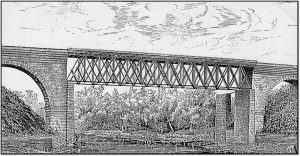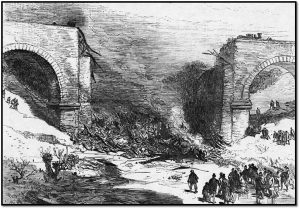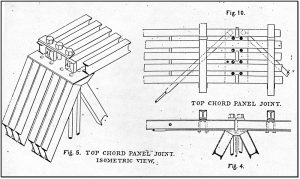The Ashtabula Bridge disaster was one of the most publicized American bridge failures of the 19th century. In 1865, the Lake Shore & Southern Michigan Railroad was faced with the task of replacing a wooden bridge over Ashtabula Creek in northeastern Ohio. The president of the railroad was Amasa Stone, who had purchased the patent rights for the Howe Bridge from William Howe, his brother-in-law, in 1841. Howe’s bridge was initially built with wooden top and bottom chords and diagonals; the verticals were wrought-iron rods in tension. Stone had built many successful Howe wooden trusses before the Ashtabula Bridge but built this one entirely of iron with cast iron for junction blocks and wrought iron for tension and compression members. The wrought iron top chord and diagonals were all fabricated from I sections and the bottom chord of wrought iron bars. The span, as built, was 157 feet and cost $75,000. All was well until the night of December 29, 1876. On this night, the eleven-year-old bridge failed, in what was called a blinding snowstorm, carrying the Pacific Express to the creek 69 feet below, resulting in the loss of 80 lives.
Stone had rejected the advice of two of his engineers, Charles Collins and Joseph Tomlinson, about the design of the bridge. Collins, who supervised the construction of the bridge, was reported to have said, “This is no bridge of mine; that is the President’s bridge.” After testifying to a Coroner’s Jury, “I never mentioned to anyone that the bridge was not mine and that I did not want anything to do with it since it was placed under the charge of a bridge man; I thought it out of place for me to say anything about it. I never knew of another bridge being built of wrought iron on this plan. I think the bridge was rather an experiment.” After he testified, he committed suicide. Tomlinson, under the supervision of Stone, made the drawings of the bridge but told Stone the braces were not strong enough. Stone then fired Tomlinson.
The press of the country, already somewhat critical of the railroads, had a field day pointing fingers, asking embarrassing questions, and wondering over and over again how something like this could happen. The Illustrated London News ran an article in its February 3rd issue, along with a full-page engraving of the train burning amidst the wreckage of the bridge. Harper’s Weekly, on January 20, 1877, ran an article and a full-page illustration of the disaster, asking questions that most people wanted an answer to, when it wrote:
“Was it improperly constructed? Was the iron of inferior quality? After eleven years of service, had it suddenly lost its strength? Or had a gradual weakness grown upon it unperceived? Might that weakness have been discovered by frequent and proper examination? Or was the breakage the sudden effect of the intense cold? If so, why had it not happened before in yet more severe weather? Is there no method of making iron bridges of assured safety and who is responsible (so far as responsibility goes) for such an accident –the engineer who designed the bridge, or the contractor, or the builders, or the railroad corporation? Was the bridge when made, the best of its kind, or the cheapest of its kind? Was the contract for building “let to the lowest bidder,” or given to the most honest, thorough workmen? These and a hundred similar queries arise in every thoughtful mind and an anxious community desire information and assurance of safety. The majority of people can not, of course, understand the detailed construction of bridges, but they do desire confidence in engineers, builders, contractors, manufacturers, who have to do with the making of them, and in the railroad companies, into whose hands they are constantly putting their own lives and the lives of those dearest to them.”
The article’s third question (bolded) was most damaging for the civil engineering profession. An iron bridge had been built for railroad traffic by Whipple in 1853, with a span of 147 feet that was still carrying traffic. The B & O had replaced its wooden bridges with iron as well, usually on the Bollman or Fink plan starting in the 1850s. Jacob H. Linville built a 320-foot span bridge at Steubenville, Ohio, in 1864, a year before the construction of the Ashtabula Bridge.
As was usually the case when fatalities resulted from a bridge failure, the only means of investigating the underlying causes was to call a coroner’s inquest that went on for 68 days. The Jury had seven conclusions, of which 3, 4, and 5 are the most important for this article,
“Third. That the fall of the bridge was the result of defects and errors made in designing, constructing, and erecting it; that a great defect, and one which appears in many parts of the structure, was the dependence of every member for its efficient action upon the probability that all or nearly all the others would retain their position and do the duty for which they were designed, instead of giving to each member a positive connection with the rest, which nothing but a direct rupture could sever…
Fourth. That the railway company used and continued to use this bridge for about eleven years, during all which time a careful inspection by a competent bridge engineer could not have failed to discover all these defects. For the neglect of such careful inspection, the railway company alone is responsible.
Fifth. That the responsibility of this fearful disaster and its consequent loss of life rests upon the railway company, which, by its chief executive officer, planned and erected this bridge.”
In addition, a special committee of the Ohio state legislature was created. They appointed three prominent engineers, who concluded, after a very comprehensive study, on January 30, 1877, that the factors of safety in the members varied widely, with the tension members very strong and the compression members very weak. They then wrote,
“The probability is that the braces failed first, and thereby involved the failure of the top chord also. But inasmuch as both members were weak, and both were involved in the break, it is of little importance which member took precedence in the failure. The factors of safety throughout the compression members were so low that failure must have followed sooner or later.
If the several groups of beams composing the braces and top chord had each been combined into a single member, by riveting on their flanges a system of diagonal plates – say three and a half by half-inch – running alternately from right to left and from left to right across the entire group, the bridge would have been abundantly safe. This arrangement would have made each group strongest in the lateral direction and weakest in the direction of the webs of the beams, but in this direction, the beams offer about five times the resistance that they do laterally. The top chord members could then only deflect in single panel lengths, and, on that account, their strength would have been still further increased – twofold. The result would have been that the factors of safety given in the tables would have been increased five times for the braces and ten times for the chord. They would have been so excessively strong that much of the material might have been omitted…
Another defect was the absence of any provision for retaining the braces in their places on the angle-blocks. Such provision had been originally made by means of raised lugs on the faces of the blocks at the corner of the flanges of the braces. But, in changing the positions of the braces, these lugs were removed, and no substitute, therefore, was provided. This allowed the braces to slip from their places, and make the already imperfect bearings still more defective…
The full legislative committee concluded,
1st – There were from eighty to one hundred lives lost by the failure of the bridge.
2d – The bridge went down under an ordinary load by reason of defects in its original construction.
3d –The defects in the original construction of the bridge could have been discovered at any time after its erection by careful and analytical inspection, such as the importance of the structure demanded, and thus the sacrifice of life and property prevented.”
Many engineers weighed in on the failure. Charles Macdonald wrote a long paper for ASCE on the failure. He wrote as an introduction,
“At the moment when the pilot of the forward engine reached the western abutment, the top chord of the south truss, which was almost directly under the train, gave way at a point about 23 feet from the west end, causing the immediate fall of the entire structure; the engineer of the first engine, feeling a sudden movement, pulled open his throttle valve and succeeded in landing his engine on [the] solid ground west of the abutment, but the remaining engine and the express cars went down with the bridge, while the passenger cars were dragged one after another over the eastern abutment into a chasm 65 feet in depth, piling one upon the other in a shapeless mass of splintered fragments which immediately caught fire and were consumed.”
After describing each element of the bridge and determining its strength, he concluded,
“The most important lessons to be learned from the event: In the interval since the accident, we have had a sufficiency of snap judgments to satisfy the most censorious. Judging from the tenor of much that has appeared in the secular press, either as evidence taken under the solemnity of an oath or by way of editorial comment, this bridge must have been conceived in sin and born in iniquity.
The President of the Company attempts to execute a difficult piece of construction, with but little special knowledge of the principles involved in his task. He ignores the advice of a chosen professional assistant and neglects to profit by the warnings which are said to have been uttered by the structure itself in the travail of its birth, and now, at the end of all these years, a dire catastrophe brings the misshapen thing back to the source from whence it sprung. In the West, a few scattering efforts had been made, and the subject was beginning to attract the attention of some of the best minds in the country. Squire Whipple, Albert Fink, Shaler Smith, Jacob H. Linville, and Thomas C. Clarke had built bridges at that time, it is true, but such names could almost be counted upon the fingers; and even these would, perhaps, now admit that they then “[built it] better than they knew.” If then, the state of knowledge at the time has not been under-estimated, the Ashtabula bridge was the result of an honest effort to improve the bridge practice of the country, undertaken by a man whose experience in wooden bridges warranted him in making the attempt. As to his willful neglect of proffered advice, it would be well to suspend judgment until all the facts are brought to light by the proper tribunals. His worst enemies will, at least, according to Mr. Stone, the possession of common sense…
First. The inspection must have been faulty. If anyone of the well-known bridge engineers of today had been asked to examine that structure, he would have pronounced it unsafe, for the principal reason that all the compression members were liable to fail by flexure…
Second. A careful study of the behavior of the compression members of this bridge must impress us with the necessity of more perfect experimental knowledge of the strength of iron in the form of struts…
Third. The failure of some of the castings conveys a useful lesson in designing details involving the use of cast-iron. Care should always be taken not to pass abruptly from a large to small mass; else, the strains from cooling will surely vitiate the strength of the connection…
Fourth. In conclusion, it may with safety be said that the Ashtabula bridge was an exceptional structure, both in its design and execution, and that the reputation of American engineers and bridge constructors of today cannot in the least be affected by its failure when all the facts are known…”
Many other engineers, such as Squire Whipple, A. P. Boller, Theodore Cooper, Edward Philbrick, Gouverneur Warren, C. Shaler Smith, Charles Hilton, and Robert Briggs, weighed in on the failure. Whipple wrote, “But it was a much greater fault, and probably the one mainly leading to the fatal result, to divide the material of the braces and upper chord into 5 or 6 slender bars, affording but little mutual support laterally, instead of consolidating a smaller amount of material in single efficient members of large diameter and lateral stiffness.” Boller wrote, “We all know it to have been a conglomeration of errors, and principally astounding in its longevity. Why it lasted a week after the staging was knocked out can only be answered by reference to the doctrine of “special providences.” That it lasted a dozen years is a superb tribute to the value of iron in bridge construction, showing the torture that material will stand before the penalty is paid, that nature exacts of ignorance. Without moralizing over the design, ignorantly conceived and faultily carried out, and one that any bridge expert would have condemned after less than five minutes inspection, the lesson of the disaster is of the highest importance to the whole community.”
The cause of the failure was a case of bad design, bad construction, and inadequate inspection. The design was never repeated.■



